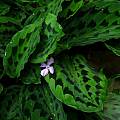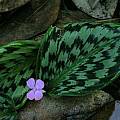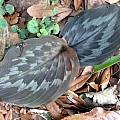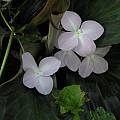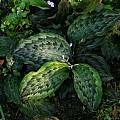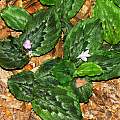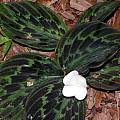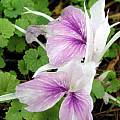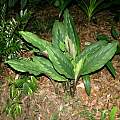Kaempferia L. is a genus in the Zingiberaceae family found in southern & southeastern Asia. These gingers grow from small globular rhizomes which grow fleshy roots. Most are low growing plants with colorfully marked foliage. Flowers either emerge in the spring just prior to the foliage or with the foliage and continue through the summer. Most species naturally go dormant for a portion of the year. Many species published as Kaempferia have over the years been transferred to the genera Boesenbergia, Scaphoclamys, Siphonochilus and others. Of the cultivated species, many are new to science. The genus has had little attention until recently and new species are finally being published. There are at least a dozen undescribed species grown by collectors in the US alone.
Kaempferia elegans Wall was originally introduced into US cultivation as Kaempferia laotica Gagnep. Kaempferia laotica is in very limited cultivation, however all commercially available plants labeled as such are forms of Kaempferia elegans. These include 'Brush Strokes,' 'Satin Checks,' and 'Shazaam.' Another form sold as 'Green Ripple' was perhaps the first form commercially available. Some taxonomists consider this species and Kaempferia pulchra to be the same but more research needs to be done regarding this. Although superficially very similar, their flowers are easily distinguishable from each other. This species is vigorous & hardy at least to zone 8. It tolerates partial sun as long as the location is not too hot. Height range: 15-20 cm.
'Satin Checks' Photos by Alani Davis.
'Shazaam' Photos by Alani Davis.
Kaempferia galanga L. is used as a tasty culinary herb in certain Asian cuisines. It is used in cooking similarly to Alpinia galanga. It is hardy to at least zone 8, surviving short duration freezes to 17 degrees Fahrenheit. Leaves are plain green in this form, but it still makes an attractive display. Height range: 30-60 cm. Photos by Alani Davis.
Kaempferia pulchra Ridl. is a highly variable species with many variants in distribution. It is hardy at least to zone 8. Leaves emerge from dormancy from May to June and plants begin flowering immediately, producing flowers through the summer and fall when they go dormant, losing their foliage. This species prefers light to moderate shade.
Kaempferia pulchra 'Bronze' is a deep burgundy leaved form with variable pewter markings. Photos by Alani Davis.
Kaempferia pulchra 'Bronze' × 'Roscoe' is as yet an unnamed hybrid of these two forms. It is horticulturally attractive with larger patterned leaves & large purple flowers with a white star pattern in the center. The commercially produced form distributed as 'Alva' is reputed to be of this parentage as well. Photos by Alani Davis.
Kaempferia pulchra a form known as mansonii, which doesn't seem to be a published variety or subspecies, quickly grows into dense clumps. Leaves emerge highly pigmented, but are nearly patternless by the mid-summer. Though less colorful than some other forms, this form is especially vigorous and floriferous. While most commercial sources list this form as 'Mansonii', it was originally introduced to horticulture as Kaempferia masonii (named after Mason, not Manson). Some growers have opted to correct both the incorrect spelling and invalid scientific name by calling it 'Mason'. Despite the lackluster late summer foliage, it has been a very useful hybrid parent. Photos by Alani Davis.
Kaempferia pulchra 'Roscoe' is now considered a large white-flowered form of Kaempferia pulchra, but at one time was distributed as K. roscoeana, which is a different plant. There has been much confusion caused by clones of K. pulchra distributed as K. roscoeana and there are several clones distributed as K. pulchra 'Roscoe' as well. Some are white flowered, some are lavender flowered, but this form seems to be more distinct than others, though it freely hybridizes with other K. pulchra clones. The plant produces larger leaves than more "typical" K. pulchra forms. Leaves emerge heavily pigmented, but these mature to predominantly green with a series of brown/black eyelash marks. Photo by Alani Davis.
Kaempferia pulchra 'Silverspot' a selection of the above form made by Tom Wood with particular band patterns on the leaves. This selection retains foliage longer and if protected is semi evergreen. Photos by Alani Davis.
Kaempferia rotunda L. is commonly referred to as Asian Crocus, however, flowers are more orchid-like in appearance. Appearing in the spring before the leaves, the flowers can be quite thick before being replaced by erect, elliptic foliage to 30 inches with burgundy undersides & silver patterns above. It becomes deciduous in the fall. This is the "common" form, but many more highly patterned forms will be available. Hardy to zone 7. Photos by Michelle Davis and Alani Davis.
